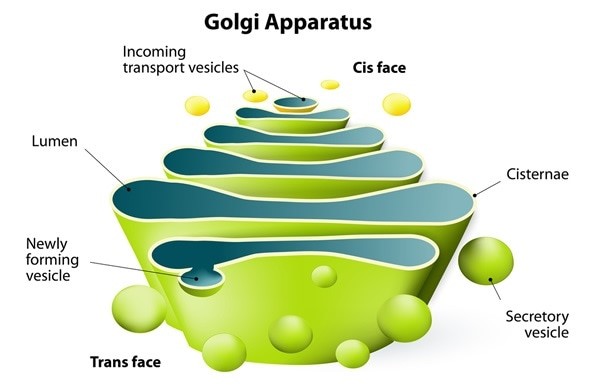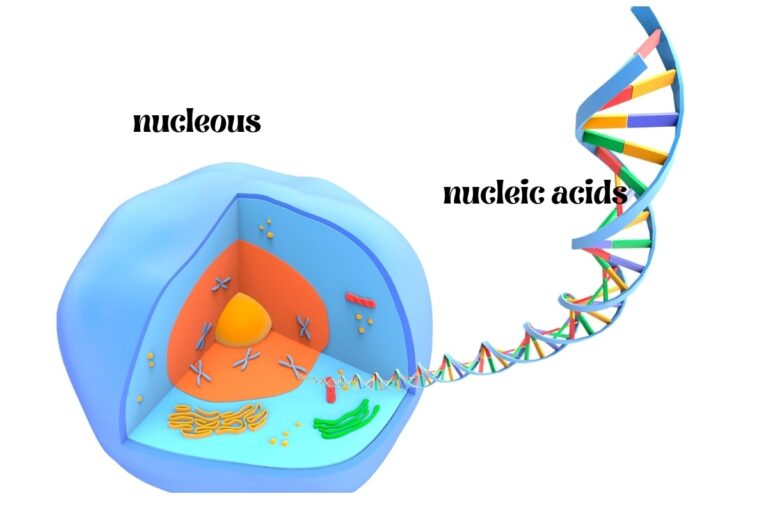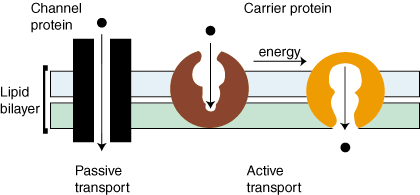Golgi Apparatus- Definition, Function, and Structure
Introduction
The Golgi apparatus is an organelle found in most eukaryotes. This organelle is located near the nucleus and endoplasmic reticulum, but it does not directly contact these structures. The name “Golgi” comes from Camillo Golgi, who first discovered the structure in 1898. This article will discuss how the Golgi apparatus works, what its Function is, and its structure.
The Golgi Apparatus Structure
The Golgi apparatus is also called the Golgi complex or the Golgi body. It is a stack of membrane-bound sacs called cisternae. These are connected by tubules that form the Golgi complex.
The organelle is made up of three levels. Its job is to modify and package proteins for transport out of the endoplasmic reticulum (and other cell structures) and synthesize certain lipids and glycoproteins. The Golgi body consists of cisternae, vesicles, and interconnecting tubules.
Cisternae
The cisternae are a stack of membrane-bound sacs inside the Golgi body, and they can be thought of as small compartmentalized vesicles stacked next to each other. The cisternae have two membranes and a central lumen which is the space inside the cisternae.
The cytosolic membrane is on the inside of the Golgi. One side faces the endoplasmic reticulum, while the other membrane is facing the interior of the Golgi. The two membranes are continuous with each other but have different compositions in lipid and protein content.
The Golgi apparatus is often referred to as the “organelle that synthesizes and packages proteins.” To do this, it takes proteins from the endoplasmic reticulum and adds certain carbohydrates to them. These structures are part of the rough ER, the outermost layer of cells in a cell.
Vesicles
The Golgi apparatus, like the endoplasmic reticulum, is made up of vesicles. However, these are smaller and are located in between the cisternae. The vesicles can take proteins from the endoplasmic reticulum and transport them to the Golgi body to be modified.
The vesicles then take these proteins back to the endoplasmic reticulum for transport, where the former are emptied by exocytosis. There are three types of these vesicles, namely secretory, transitional, and clathrin-coated vesicles.
Secretory vesicles
The Golgi apparatus forms secretory vesicles which store molecules like proteins, lipids, glycolipids, and saccharides. They also have a membrane of their own, and the Golgi apparatus does not surround these vesicles.
Secretory vesicles transport molecules out of the Golgi apparatus to other parts of the cell, such as the endoplasmic reticulum or secretory granules. These vesicles are also responsible for synthesizing some of these molecules, such as lipids, glycolipids, and saccharides.
Transitional Vesicles
The transitional vesicles are also called the reticular-type or tubular transport vesicles. These are found in between two cisternae, and they are continuous with the Golgi apparatus. These vesicles have a multilayered membrane, which is made up of phospholipids and proteins.
Transitional vesicles transport lipids, carbohydrates, enzymes, and other substances from the cisternae to the trans-Golgi network. The vesicles are then emptied by exocytosis into the cisternae of the cell membrane.
Clathrin-coated Vesicles


Clathrin-coated vesicles are also called coated pit vesicles. These are found in the Golgi apparatus, and they have a clathrin coat on the outside of them. The vesicles are responsible for concentrating and sorting molecules, which is done by taking them from the cisternae and delivering them to other parts of the cell. The clathrin coat is made up of small protein chains that are specialized for this process.
The Interconnecting Tubules
The interconnecting tubules are found between the cisternae, and they can be thought of as a transport system for molecules within the Golgi apparatus. The tubules are made up of proteins that form a continuous network with the ER and Golgi cisternae. They also have a continuous membrane with the ER.
The tubules are responsible for transporting molecules, such as proteins and lipids, from one part of the Golgi. They are also responsible for providing structural support and strength within the Golgi apparatus.
What Are the Functions of The Golgi Apparatus/Golgi Complex?
- The Golgi apparatus is responsible for transporting molecules and sorting them. It does this by taking materials from the endoplasmic reticulum and modifying them.
- The Golgi complex also aids in synthesizing molecules, such as lipids and saccharides found in the cell.
- The Golgi apparatus makes up a system of transport for molecules within the structure. This transport is done through tubules that connect the different parts of the Golgi.
- In general, all molecules are transported through this system, and certain enzymes modify them.
- The Golgi plays a role in the creation of organelles like lysosomes and plasma membranes, among others.
- It also helps in the creation of proteins, such as hormones and enzymes.
- Modifying proteins by adding sugar groups
- Packing and sorting molecules
- The Golgi organizes cellular components by compartmentalization.
The Function of the Golgi apparatus in Chloroplasts
In chloroplasts, the Golgi is responsible for the synthesis of photosystems I and II. In addition to this, it also helps with lipid metabolism and glycoprotein production.
The Golgi also regulates the envelope which surrounds a chloroplast, and it helps with photosynthesis as well. It does this by helping with the production of chlorophyll and carotenoids.
The Molecule Modification Role of the Golgi Apparatus
The Golgi apparatus is responsible for modifying molecules that it takes from the ER. The two main ways in which this happens are through glycosylation and phosphorylation.
The Golgi complex adds sugar groups made of glucose and mannose to proteins. This addition alters the molecule’s properties, such as making them more hydrophilic or lipophilic. The Golgi also adds phosphate groups to proteins, which is what gives them their electric charge. The charge facilitates the transport of the molecules through membranes.
Some of the modified molecules go to the cell membrane, while others go to the mitochondria. The molecules meant for the cell membrane are phosphorylated, making it easier for them to be transported.
Those molecules going to the mitochondria are glycosylated to increase their chances for transportation. The Golgi apparatus also modifies lipids by adding fatty acids to them so that enzymes don’t break the lipids down.
The Golgi also helps with synthesizing glycolipids, which are lipid molecules with sugar chains attached to them.
The Role of the Golgi Apparatus as a Transport Network for Molecules
The Golgi apparatus can be seen as a transport network for molecules. It can do this due to the tubules that connect the different parts of the Golgi.
The tubules are found between the cisternae, and they transport materials from one part to the other. This transportation is vital for those materials that are needed in other parts of the cell.
The tubules can also transport molecules to either the endoplasmic reticulum or the cell membrane.
How Do The Cis Golgi Network and Trans Golgi Network Co-function?


The cis Golgi network and trans-Golgi network work together in coordinating the functions of the organelle. As its name suggests, the cis Golgi network is found on the inside of a cell. It connects to different cells and helps transport material from one part of the organelle to the other.
This network regulates the transport of proteins and lipids around the Golgi complex. It also helps with the production of molecules such as ribosomes, lysosomes, and peroxisomes.
The trans-Golgi network is located on the outside of a cell and connects to other cells. It takes materials from the cis Golgi network and transports them to the endoplasmic reticulum. The trans-Golgi also has its own set of functions. It receives molecules from the endoplasmic reticulum and transports them to the cell membrane.
Trans-Golgi Network in Plants and Yeast
In plants and yeast, the Golgi is classified as a trans-Golgi network, meaning that it sends its products to other cells or the cell membrane. It is responsible for transporting molecules that are meant for storage in vacuoles or lysosomes.
In yeast, the Golgi transports molecules to mitochondria and peroxisomes. It also helps with the production of lysosomes and ribosomes.
What are Some of the Golgi Apparatus Distinguishing Characteristics?


- The Golgi apparatus has a fluid, sac-like structure.
- It is made of stacks or “cisternae” that are connected.
- The cisternae are arranged almost like a stack of pipes, and they have two membranes, each with specialized functions within the Golgi apparatus.
- The cisternae are made up of a thin membrane that surrounds the sac, and it is responsible for enclosing the vesicles and allowing them to fuse with the Golgi apparatus.
- The other membrane, made up of phospholipids and proteins, allows for the transport of molecules from one cisterna to the other.
- The Golgi complex also has a reticular-type or tubular transport vesicle and a clathrin-coated vesicle.
- The Golgi apparatus is found behind the plasma membrane or cell wall.
- The Golgi is also found in the cytoplasm of a cell, which is located outside of the nucleus.
- The Golgi apparatus can disassemble and reassemble itself depending on the needs of a cell.
Golgi Apparatus Disassembly and Reassembly
The Golgi apparatus can disassemble and reassemble during cytokinesis. The typical Golgi shape is a stack of vesicles, but the whole structure can disassemble and reassemble due to its dynamism.
During the mitosis stage, the Golgi apparatus undergoes a change in shape called disassembly and reassembly. This process is due to the cell’s need for a lot of material to create the new plasma membranes associated with two daughter cells.
First, the Golgi apparatus begins to disintegrate. Then, after some time, the Golgi reassembles. This process is very dynamic, and scientists did not understand how or why this disassembly and reassembly occurs until recently.
The proteins responsible for this process are trans-Golgi network resident proteins (TGN-RP). These proteins have been known to be essential for Golgi Function. TGN-RPs assist in regulating Golgi bud number and are also involved in the disassembly of vesicles from the Golgi apparatus to the endoplasmic reticulum during cytokinesis.
For the Golgi disassembly to occur, the Golgi and endoplasmic reticulum (ER) must be connected. The TGN-RPs travel through the Golgi stacks, attaching themselves to lipid droplets, and aid in the budding of large Golgi vesicles. They then travel to the ER, where they disassemble the Golgi stacks and complete the process of cytokinesis.
You may be interested in Extracellular Matrix Function
Summary
The Golgi apparatus is a type of organelle that has many essential functions. It’s located near axons and dendrites, which means it can be found near cell bodies as well.
The structure of the Golgi apparatus is also worth noting because it contains stacks of flattened membrane sacs called cisternae within them. These sacs transport newly formed proteins into other cell parts for use or storage, depending on their Function.


I‘m a freelance content and SEO writer with a passion for finding the perfect combination of words to capture attention and express a message. I create catchy, SEO-friendly content for websites, blogs, articles, and social media. My experience spans many industries, including health and wellness, technology, education, business, and lifestyle. My clients appreciate my ability to craft compelling stories that engage their target audience, but also help to improve their website’s search engine rankings. I’m also an avid learner and stay up to date on the latest SEO trends. I enjoy exploring new places and reading up on the latest marketing and SEO strategies in my free time.







